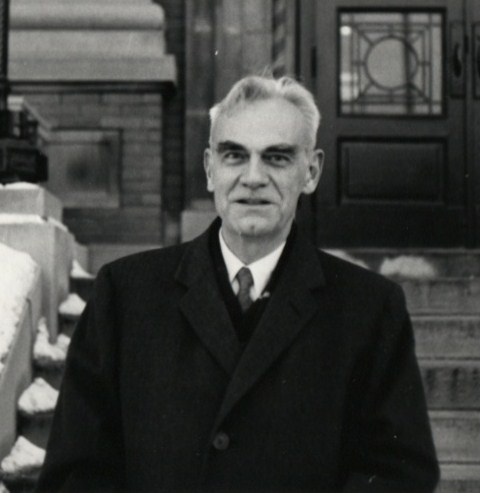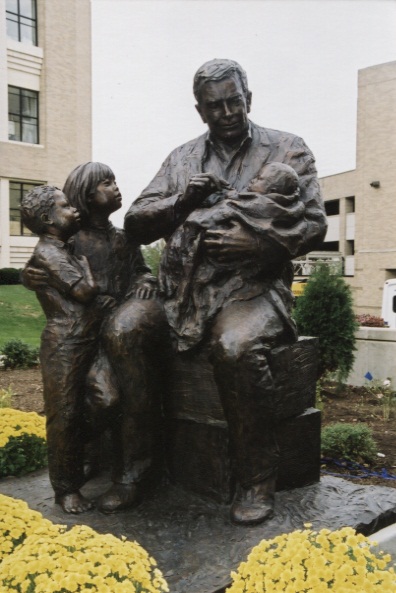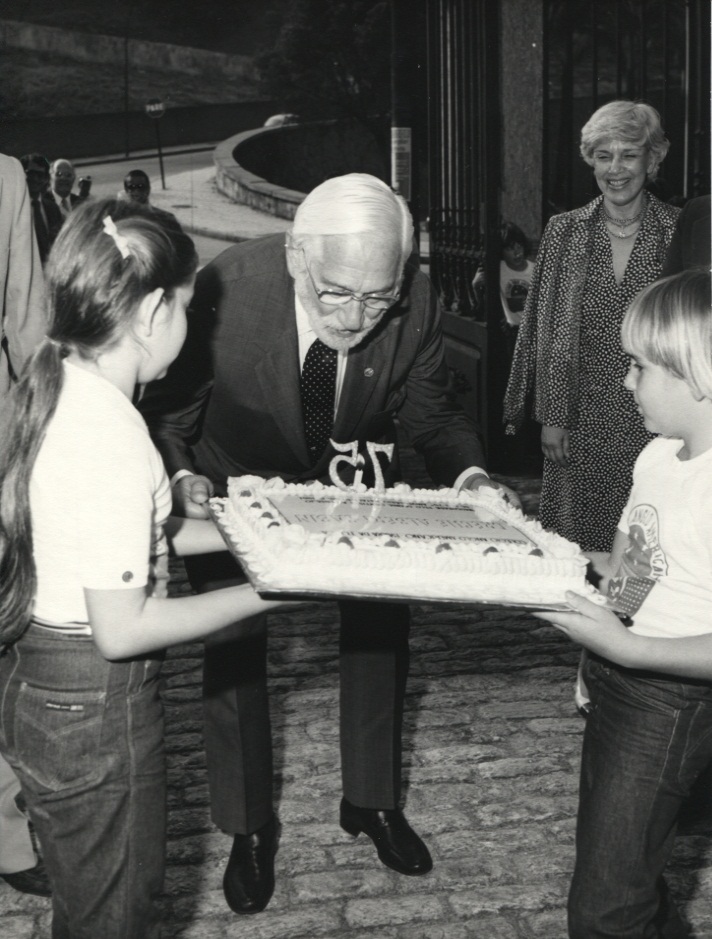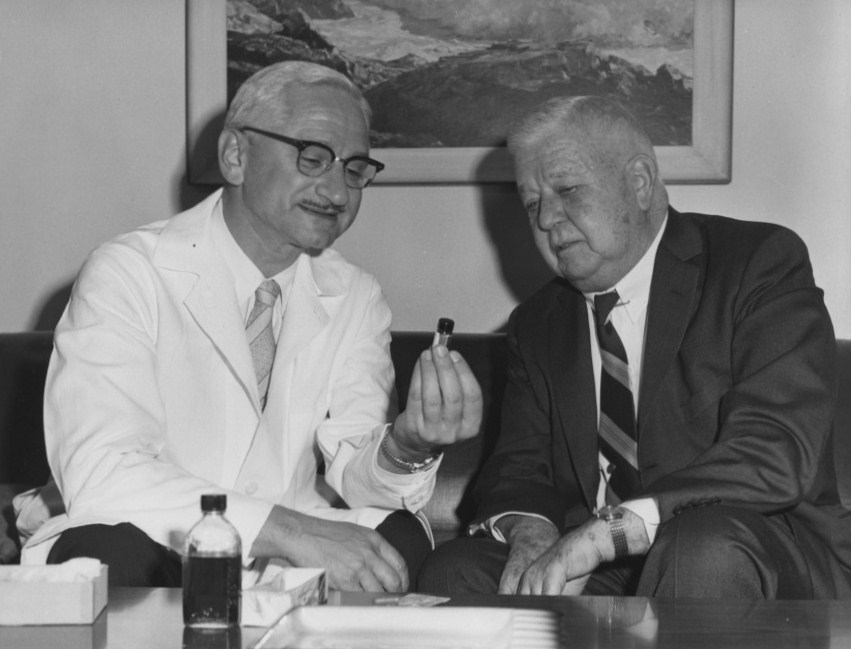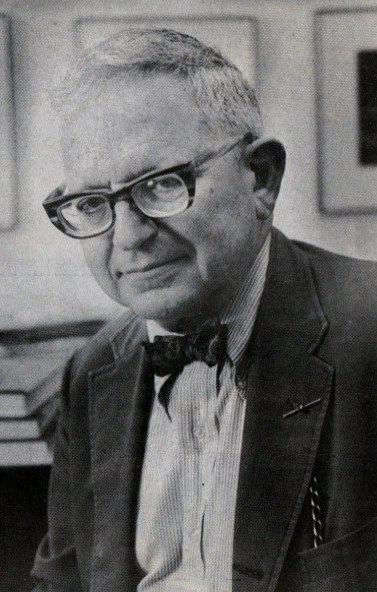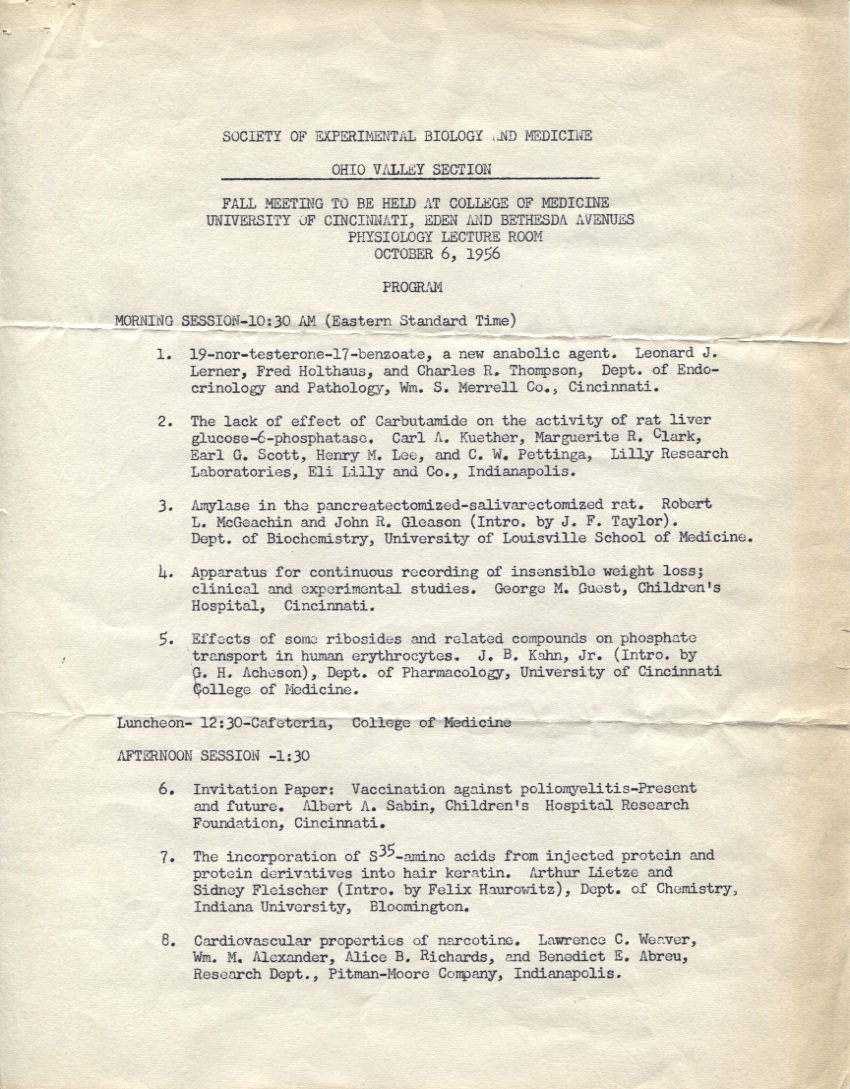Since I have started the next phase of the Sabin digitization project, I have encountered several letters between Dr. Sabin and Dr. Charles D. Aring, an internationally known neurologist who served as a professor and department chairman in the University of Cincinnati’s Department of Neurology from 1948-1974. It turns out that one of the Winkler Center student assistants, Miranda Scharf has been working to update the EAD-compatible finding aid for the Charles D. Aring papers, which reside in our archives. (Be on the lookout for an official announcement in the Winkler Center blog soon!) I thought I would highlight some materials in both of their manuscript collections to give you an idea of their relationship. Continue reading
Category Archives: Digital Collections
The Albert B. Sabin Digitization Project: The Rotary Polio Plus Sculpture
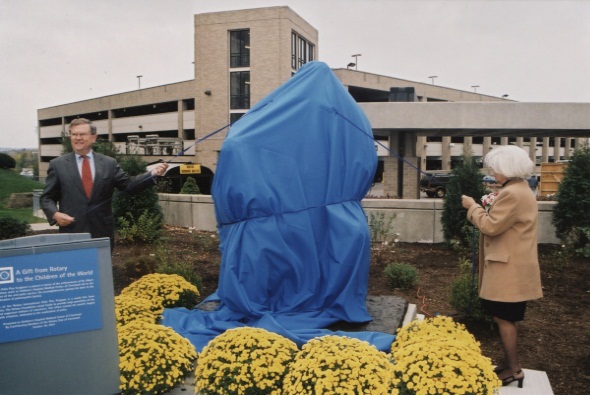
October 26, 2001 - Unveiling the Rotary Polio Plus sculpture. Mrs. Sabin can be seen in this photo on the right. (From the collection of Bruce Cook.)
[Sabin Archivist’s Note: This week features the first blog post from Megan Ryan, the Sabin Project student assistant. Megan is pursuing a Master of Community Planning from the College of Design, Architecture, Art and Planning here at the University of Cincinnati. She will be blogging on different Sabin-related topics as we work on the project. Please give Megan a warm welcome to the blogging world by reading her posts! -SB]
By Megan Ryan, Sabin Project Student Assistant
Last month, Stephanie and I went on a field trip to speak to past Rotary International Director, Bruce Cook. We sought insight into the involvement of Honorary Rotarian, Dr. Sabin, with Club 17. The Rotary Club of Cincinnati is given this title because it was the 17th Rotary Club formed in the United States in 1910 (the first was formed in Chicago in 1905). Mr. Cook told us many stories about Rotary, including when he met Dr. Sabin for the first time.
When the Rotary Polio Plus Sculpture was discussed, it struck me how wonderful it is that there is a physical reminder of the immeasurable impact of Dr. Sabin’s polio vaccine and the work of Rotary International. The Polio Plus Program was launched by Rotary International in 1985, and is the largest private sector support of the Global Polio Eradication Initiative. As Mr. Cook said, “This statue symbolizes the 20-year commitment of countless Rotary members who are making their vision a reality and the world healthier for millions of children.”[1] Built in 2001, the seven foot tall, eight-hundred pound sculpture depicts a Rotarian vaccinating an infant while two children await their turns. The sculpture is located near the emergency department entrance and the clock tower at Cincinnati Children’s Hospital. Continue reading
The Albert B. Sabin Digitization Project: Sabin and Summer Grippe
The book The Polio Paradox: Uncovering the Hidden History of Polio to Understand and Treat “Post-Polio Syndrome” and Chronic Fatigue by Richard L. Bruno, H.D., Ph.D., has been sitting on my shelf for a while. I thought it would be interesting to tell you a bit about his discussion of Sabin, particularly because Dr. Bruno used the Sabin archives when he was researching this book.
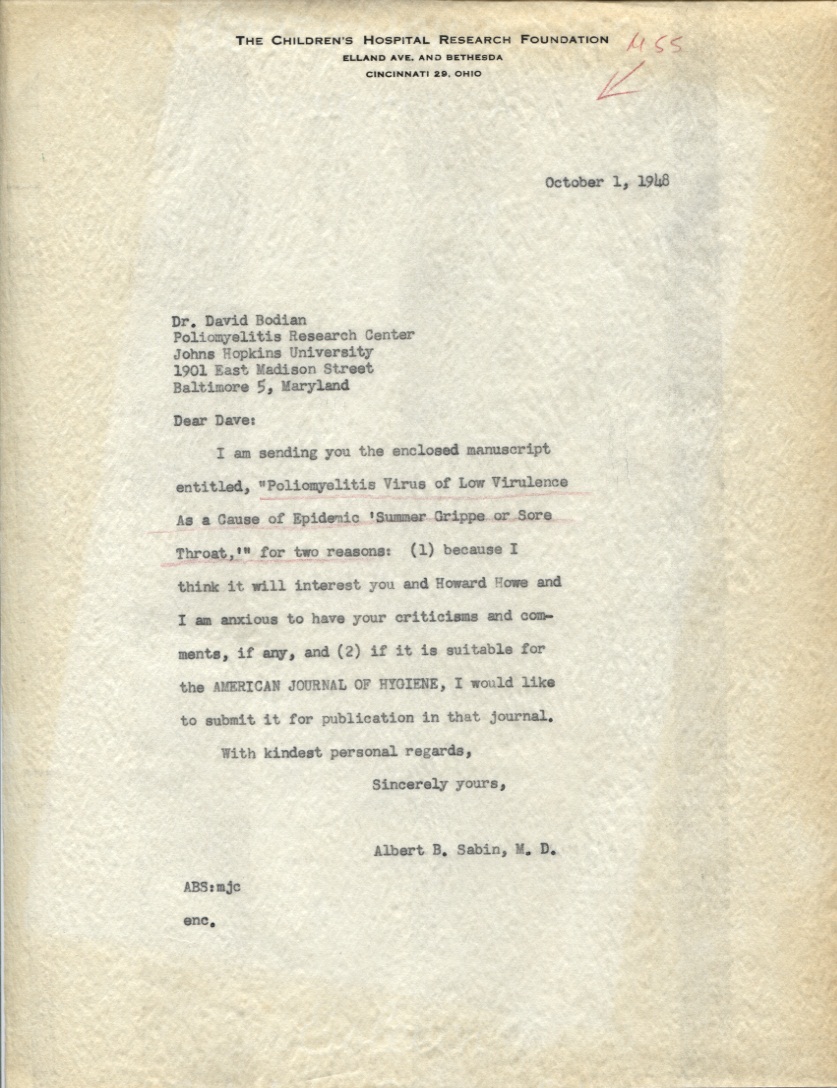
October 1, 1948 - Letter from Dr. Sabin to Dr. Bodian, asking for comments on his article, as well as its appropriateness for the American Journal of Hygiene
For your information, Dr. Richard L. Bruno is the director of the Post-Polio Institute and the International Centre for Polio Education. He is known as an expert on Post-Polio Sequelae and has written several books and articles on the topic. His book tries to help people understand “Post-Polio Syndrome,” which the Mayo Clinic describes as “a cluster of potentially disabling signs and symptoms that appear decades — an average of 30 to 40 years — after the initial polio illness.” Continue reading
The Albert B. Sabin Digitization Project: Finding Aid Now Available
As mentioned in a previous blog post, the Sabin project student assistant Megan and I have been diligently working on creating a tool to help researchers find information in the Hauck Center for the Albert B. Sabin Archives and help them gain access to the materials in the collection. In the archival profession, we refer to this type of tool as a “finding aid.”
Today, we are happy to announce that the finding aid for the Albert B. Sabin Archives can now be found in the OhioLINK Finding Aid Repository! To access the finding aid, please follow the link below:
Finding aid for the Albert B. Sabin Papers, 1930-1993
By creating this tool using Encoded Archival Description (EAD), this finding aid is now completely searchable, which will allow our online visitors to search our collection much easier. We hope that this will help users across the globe have a better understanding of the materials we have. As we delve further into the Sabin digitization project, this finding aid will be updated to reflect any changes.
If you see material listed in the finding aid that you may be interested in, please contact the Henry R. Winkler Center at (513) 558-5120 or chhp@uc.edu. Continue reading
The Albert B. Sabin Digitization Project: An Example of International Cooperation
Last week, I discussed parts of Dr. Saul Benison’s book on Tom Rivers that related to Dr. Sabin. One thing I didn’t include was when Dr. Benison asked Dr. Rivers about how countries were chosen to conduct field trials for the Sabin vaccine. Dr. Rivers said, “No one chose the country. Generally, it was the public health officials or virologists of a given country that did the choosing, and usually for reasons of their own.”[1] Dr. Rivers then proceeded to discuss how Czechoslovakia came to be part of the field trials. Instead of giving you Dr. Rivers’ brief account of it, I thought I would share some letters that tell the story. It’s actually a great example of international cooperation.
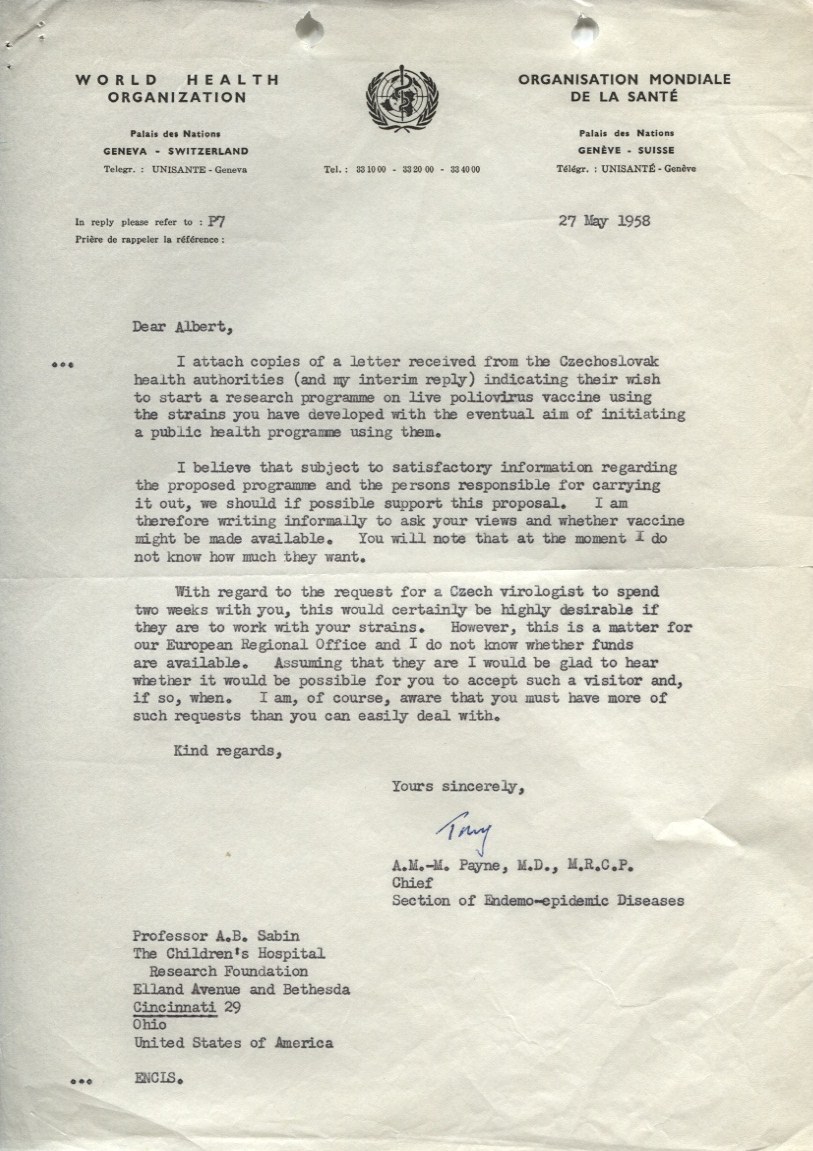
Letter from Dr. Payne to Dr. Sabin regarding the interest in the oral polio vaccine by the Czechoslovak health authorities, May 1958.
In May 1958, Dr. A. M.-M. Payne, Chief of the Endemo-epidemic Diseases Section of the World Health Organization, wrote to Dr. Sabin and included a copy of a letter from the Ministry of Foreign Affairs in Czechoslovakia. The letter from Czechoslovakia said, “[T]here are favourable conditions for organising a highly specialized and extensive epidemiological and virological control of large scale immunisation with living vaccine.” They hoped to begin working on the research program with Dr. Sabin’s virus strains in later on in 1958.[2] With regard to this potential research program, Dr. Payne wrote the letter to Dr. Sabin seen on the left, where he said, “I believe that subject to satisfactory information regarding the proposed programme and the persons responsible for carrying it out, we should if possible support this proposal.”[3] Continue reading
The Albert B. Sabin Digitization Project: Sabin and Rivers
I finally had a chance to pick up Dr. Saul Benison’s oral history memoir on Dr. Thomas Rivers that I briefly mentioned in a previous blog post, so I thought I would share some information in the book that readers may find interesting. First, I wanted to share a little bit about Thomas Rivers. According to the American Philosophical Society, Dr. Thomas Rivers was an important virologist who was the director of the Rockefeller Institute from 1937-1955, and served as the Medical Director and Vice President for Medical Affairs for the National Foundation for Infantile Paralysis during his career. Today, Dr. Rivers is considered the father of modern virology.[1] Continue reading
The Albert B. Sabin Digitization Project: Dr. Sabin’s Name, Take 2
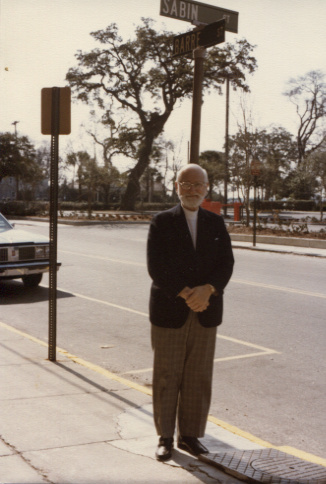
This "Sabin Street" sign is located on the campus of the Medical University of South Carolina in Charleston, South Carolina.
The Sabin project student assistant Megan Ryan and I have been working very hard on converting the Sabin collection inventory into a web-based finding aid for the archives, which will be accessible online next week. For those of you that don’t know, according to the Society of American Archivists, a finding aid is “a tool that facilitates the discovery of information within a collection of records,” or “a description of records that gives the repository physical and intellectual control over the materials and that assists users to gain access to and understand the materials.” In the case of the Albert B. Sabin archives, this finding aid will help users across the globe have a better understanding of the materials we have in our collection, as well as help the Winkler Center provide access to the collection to its users. We have used the Encoded Archival Description (EAD) format, which is the standard used by archival repositories worldwide and endorsed by the Society of American Archivists. Continue reading
The Albert B. Sabin Digitization Project: World Polio Day
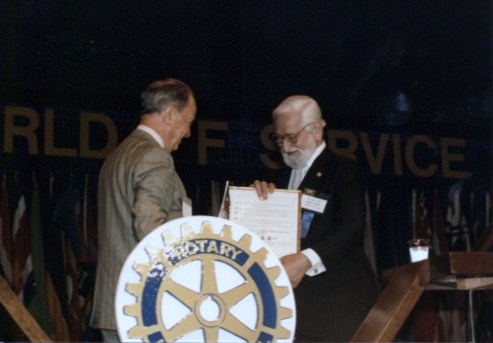
Found in the Sabin Archives - Dr. Sabin receives “Rotary Award for World Understanding” at the 1985 RI Convention in Kansas City, Missouri.
October 24 is World Polio Day, which is sponsored by Rotary International. Since 1985, with the implementation of the PolioPlus program, this organization has been working to end polio throughout the world. As I had mentioned in my first blog post, there are only four countries in the whole world – Afghanistan, India, Nigeria and Pakistan – where polio is still considered “endemic.” Due to the massive effort of Rotary International and its partners, through the Global Polio Eradication Initiative, less than 1,700 polio cases were reported in 2009. World Polio Day is an effort to bring attention to the fight against polio. Rotary International’s “End Polio Now” website states, “As long as polio threatens even one child anywhere in the world, children everywhere remain at risk.” Continue reading
The Albert B. Sabin Digitization Project: A Polio Research Collaboration
Recently, I was reading a chapter on the history of polio research by Saul Benison, a former professor of history at the University of Cincinnati. Prior to coming to Cincinnati, Dr. Benison held a notable position as the historian for the National Foundation for Infantile Paralysis (see a previous blog about this organization). During this time, he wrote a memoir of virologist Thomas Rivers, which received much acclaim when it was published in 1967. While at Cincinnati, Dr. Benison worked extensively on a biography – really an oral history – about Dr. Sabin, but this book was never published.
Dr. Benison’s chapter on polio research began in 1907 with Dr. Simon Flexner and discussed over 50 years of poliomyelitis research. Of course, no history of this disease can be covered without discussing Dr. Sabin. In one part of the chapter, Benison recalled a 1956 conference sponsored by the National Foundation for Infantile Paralysis, which gathered scientists together to help Dr. Sabin in “choosing stable nonpathogenic virus strains” for the oral polio vaccine (p. 331-32). Dr. Benison wrote that the information that Dr. Sabin received from this conference allowed him to “successfully [adapt] Dr. Renato Dulbecco’s plaquing techniques for the selection of attenuated virus strains suitable” for the vaccine (p. 332). Continue reading
The Albert B. Sabin Digitization Project: October 6, 1956
A recent Wired.com blog post highlighted an important day in the development of the oral polio vaccine: October 6, 1956. On this date, Dr. Sabin gave an invited paper at the Society of Experimental Biology and Medicine meeting held in Cincinnati. His paper was called “Vaccination against Poliomyelitis – Present and Future.” It was at this meeting that Dr. Sabin reported that he had developed a polio vaccine using three attenuated poliovirus strains, which provided an “immunizing, symptomless infection” when it was administered orally to over 50 volunteers. He also announced that his live-virus polio vaccine was ready to be tested on “increasingly larger numbers of humans both in this country and in association with qualified investigators abroad.”[1]
In the days following this meeting, several newspapers covered the contents of his paper, with headlines such as:
- “Live Polio Vaccine Found – Cinti’s Dr. Sabin Develops Oral Serum,” Cincinnati Times-Star 10/6/1956
- “One-Dose Oral Vaccine Against Polio Revealed,” The Washington Post and Times Herald 10/7/1956
- “Live Vaccine Promises Lifetime Polio Immunity,” The Sunday Star (Washington D.C.) 10/7/1956
- “New, Take-by-Mouth Polio Vaccine Found,” The Miami Herald 10/7/1956

